Climate Adaptation 101
As the effects of climate change intensify, the need to prepare communities, minimize harm, and plan for future impacts has never been clearer.
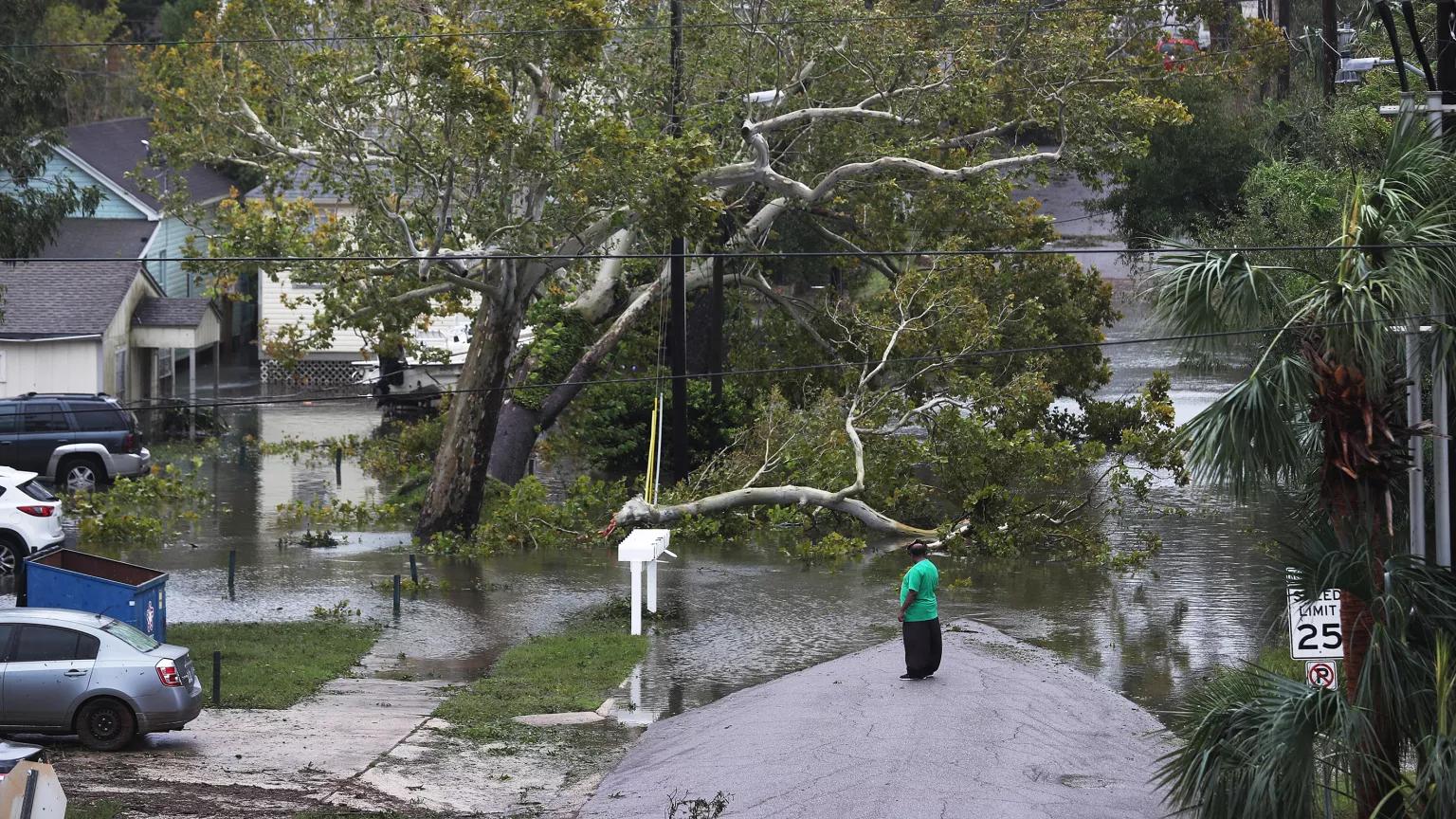
A person looks onto a flooded street as Hurricane Sally brings heavy rain, high winds, and a dangerous storm surge through Pensacola, Florida on September 16, 2020.
Joe Raedle/Getty Images
Climate change has already altered the world we live in. Wildfires, hurricanes, and other severe storms are becoming more and more intense. Sea level rise is destroying homes and communities, while extreme heat is increasingly taking lives and compromising our ability to work. Higher temperatures are threatening food and water supplies, a million species are going extinct, and these trends will only continue as climate change worsens. That is why it is no longer enough to only focus on addressing the causes of climate change—what's known as climate mitigation. Governments and communities have to start adapting to a warmer world.
What is climate adaptation?
Climate adaptation encompasses the actions we take to protect our communities and natural systems from climate hazards that are either being felt now or that have become unavoidable. These actions reflect a critical recognition by national, state, and local communities that the climate crisis is before us, that we’re already experiencing its effects, and that we must make significant changes now to lessen the damage. Climate change mitigation and adaptation are two sides of the same coin: They’re both necessary to respond to the reality of climate change.
Adaptation can take many forms, but generally, it requires collaboration across many disciplines and all levels of government to achieve a mix of policy changes pertaining to everything from land management to investment in infrastructure to public health safeguards. It may mean helping homeowners deal with more frequent flooding, ensuring that people stay safe in extreme heat, or supporting natural systems like fisheries, which face added threats due to changing conditions. And the steps we take to adapt must go hand in hand with actions to end our reliance on fossil fuels. Intrinsic to all of these efforts is a responsibility to center the people who shoulder most of the burden of climate change—low-income communities and communities of color.
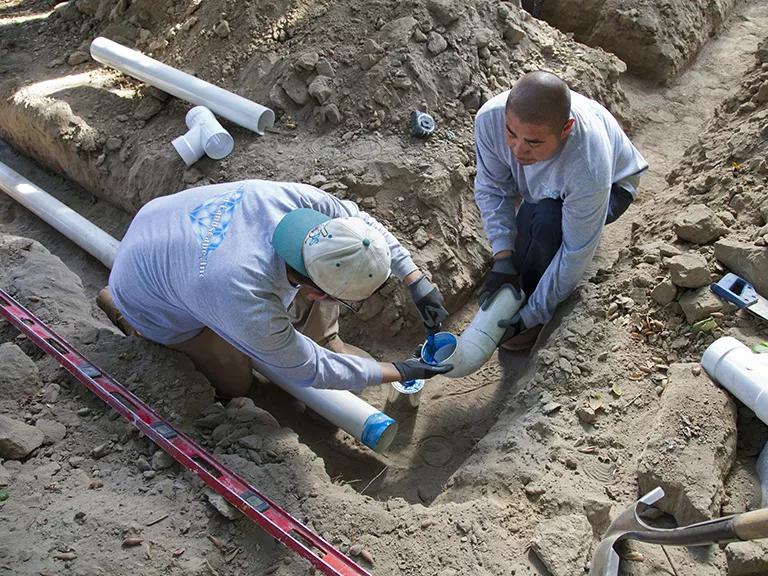
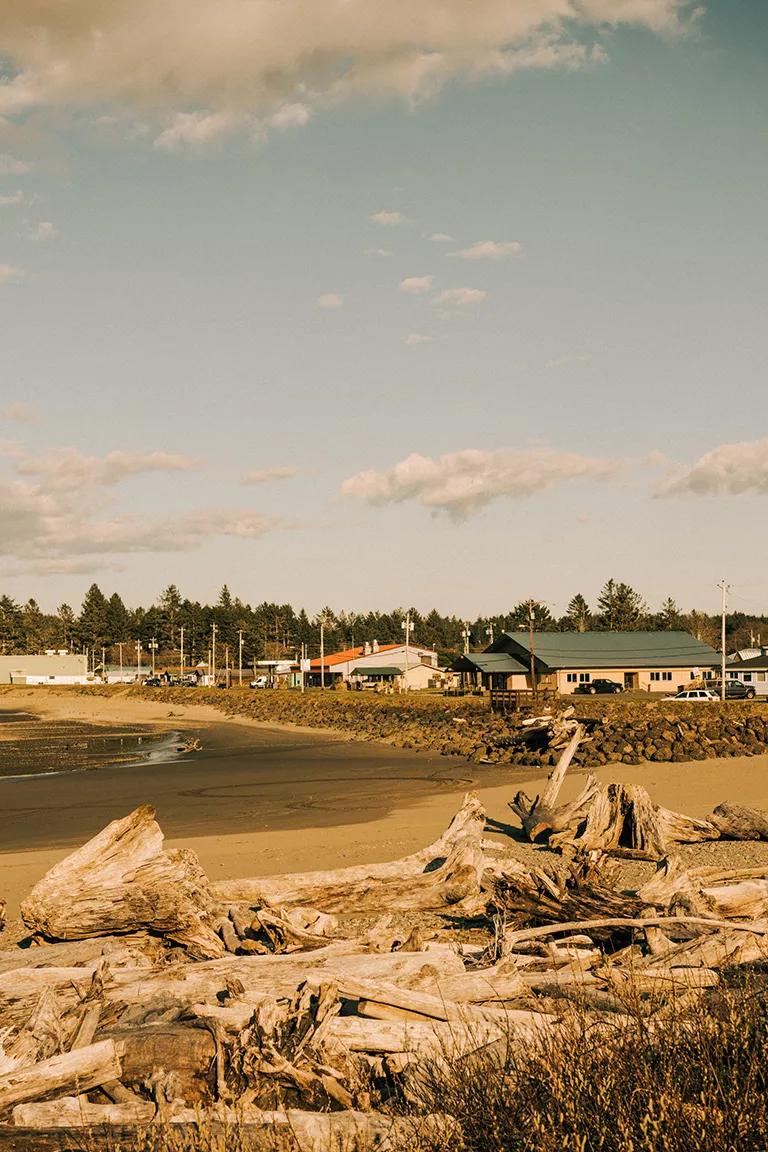
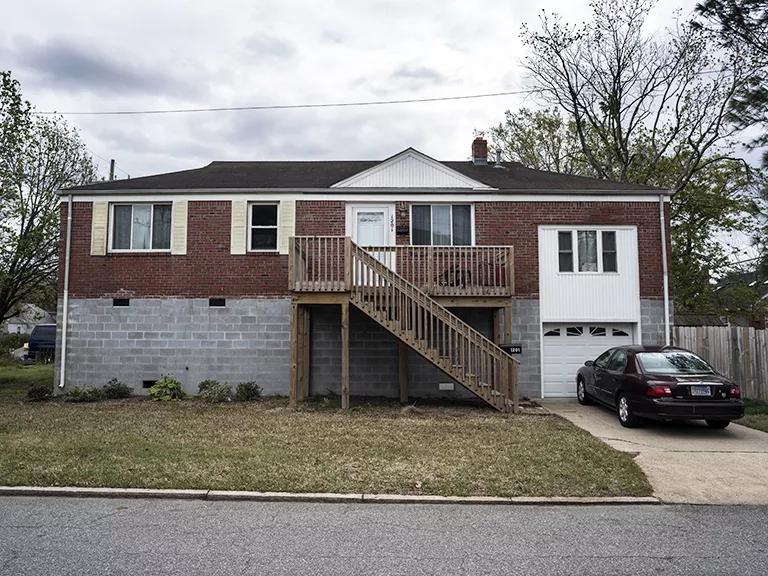
1) Workers install a rainwater harvesting system at a new home in Los Angeles. 2) The village of Tahola in the Quinault Reservation in Washington sits near the coast, exposed to storms and flooding. 3) Houses raised by FEMA on Richmond Cresent Street in Norfolk, Virginia
Citizen of the Planet/Education Images/Universal Images Group/Getty Images
; 2)Josue Rivas/The New York Times
; 3)Benjamin Lowy/Getty Images
Community adaptations for extreme weather events
Climate change is a global issue, but its impacts are being felt the most on a local scale. This is why adaptation is often happening fastest at the community levels—albeit these efforts are most successful when backed by state and federal support. For example, since 2015, the Federal Emergency Management Agency (FEMA) has required that all states consider what future climate impacts they face and outline them in their State Hazard Mitigation Plans. States have to complete these plans in order to become eligible to receive federal funding for any pre-disaster mitigation projects they want to undertake.
The policies and examples that follow reflect solutions to deal with the direct impacts of increasing flooding, sea level rise, droughts, and heat waves hitting communities across the map—adaptations that can serve as models to help us move forward together.
Coping with sea level rise and inland flooding
Our federal government must do more to make sure people are aware of the potential for flooding when they are deciding where to live. This includes updating FEMA flood maps to help raise awareness about flood risk and account for future sea level rise and extreme storms.
It means adopting flood disclosure laws to ensure that homebuyers and renters are made aware of past flood damages to a home or building before they choose a new home. The National Flood Insurance Program must also ensure this information is more readily available. The private sector, too, has a role to play: For example, the website Realtor.com now gives homebuyers information about flood risks.
Individual state policies must take into account the specific threats local residents face. For example, in New Jersey, sea level has risen 1.5 feet since the early 1900s, and more than half of that rise happened in the last 40 years. By 2030, coastal areas could see as much as a 1.1-foot rise in sea level. Given the fact that this trend is expected to keep accelerating in the future, the state is prioritizing adapting its land use regulations to incorporate resilience into new construction, storm management design, and stormwater management. Meanwhile, in Louisiana—which is projected to lose 3,000 square miles of land and wetlands along its coasts over the next 50 years if no action is taken—officials are taking actions to mitigate increased risk of storm surge and flooding. Louisiana’s Strategic Adaptations for Future Environments plans include not only structural interventions like levees but also ecological restoration efforts and a rethinking of where and how development would take place in the future.
Louisiana’s plans acknowledge that in some places, like Isle de Jean Charles—an island that has already largely eroded—conditions are expected to get so bad that its residents, who mostly belong to the Isle de Jean Charles Biloxi-Chitimacha-Choctaw tribe, have already been forced to relocate. This is called “unbuilding,” and it is usually considered in areas where the only way to protect communities is by helping move them out of harm’s way through government-sponsored retreat and voluntary buyouts. From 1989 to 2017, FEMA funded 43,633 voluntary buyouts of flood-prone properties.
However, according to a 2019 NRDC report, few current buyout practices are rising to the challenge, with more than five years elapsing between a flood and the completion of the typical buyout project. During this time, homes sometimes flood several times over. Long wait times make buyouts less accessible, less equitable, and less effective, especially since many of the homeowners who are left waiting tend to be lower-income residents. Low-income communities and communities of color are disproportionately more likely to live in flood-prone neighborhoods due to the legacy of redlining and underinvestment in flood mitigation infrastructure. For climate adaptation to be achieved through unbuilding, the current system of buyouts will need to be improved to eliminate long delays and get people to safer, higher ground.
Our drinking water infrastructure and sewage treatment plants are also increasingly at risk from the impacts of more violent storms and hurricanes. Catastrophic flooding can overwhelm and effectively end water treatment, sometimes leading to spills or release of toxic materials or raw sewage into waterways that then end up in our tap water. NRDC has petitioned FEMA to establish higher flood protection standards for these types of critical infrastructure. Utilities must also consider flood-proofing key structures and equipment, or even moving to higher ground, where necessary. Other adaptation measures include the installation of additional water storage so intakes can be shut off in the event of a spill or contamination, and the storage of more water at higher elevations. (Of course, other types of extreme weather must also be accounted for through these adaptations, which may mean, for example, burying pipes deeper and insulating infrastructure against cold snaps and extreme heat, or relying on more renewable energy produced on-site to ensure backup power in the event of a blackout.)
Cities in particular play a frontline role in addressing flooding impacts. Boston, for example, has a number of projects underway to protect its shoreline, including elevating waterfront parks to block flood entry points and restoring wetlands, living shorelines, sandy beaches, and rocky shores. Further south, Norfolk, Virginia, a low-lying coastal city with 144 miles of lake, river, and bay shoreline, has worked over the past decade to raise streets, install pumps, reclaim former waterways, reconstruct filled wetlands, stabilize beaches, and build major floodwalls. Officials there have also adopted new planning and building codes to account for future sea level rise and flooding while offering incentives to build in less flood-prone areas. Meanwhile, across the country, the Quinault Indian Nation on the Pacific coast of Washington’s Olympic Peninsula has been working toward moving its village of Taholah to higher ground as sea levels rise and the community’s shoreline erodes. The federal government recognizes the special risk faced by coastal communities, and in 2023, allocated $2.6 billion to support climate resilience and marine conservation projects in these communities; the funding was made possible by the Inflation Reduction Act and distributed through the National Oceanic and Atmospheric Administration.
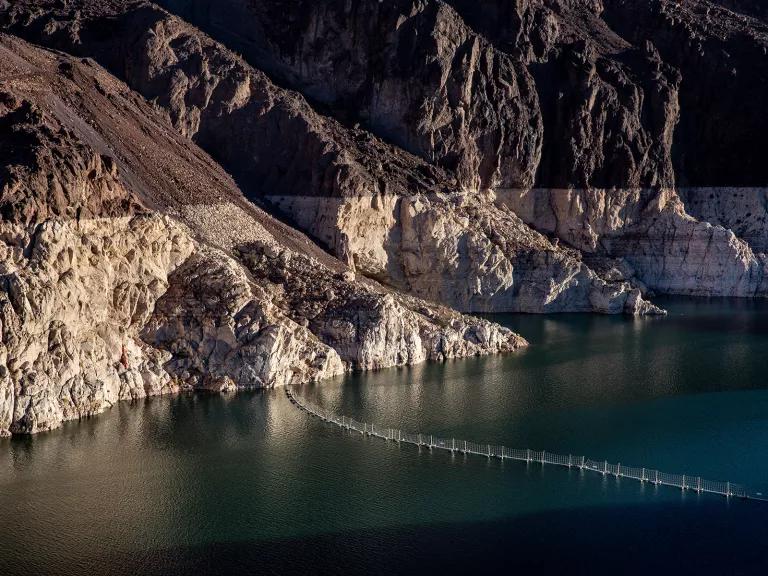
Lake Mead, the country's largest man-made water reservoir, stands at less than half of its capacity, as viewed on August 14, 2023 near Boulder City, Nevada. The lake serves water to Arizona, California, Utah, Colorado, and Nevada, as well as parts of Mexico, providing fresh water to nearly 20 million people and large swaths of farmland.
George Rose/Getty Images
Preparing for droughts
Drought is often called a “creeping disaster” because you don’t know when it starts, and its effects can accumulate slowly. But drought can still be devastating, compromising crops and water supplies, causing job losses, affecting air quality, imperiling aquatic life, and creating dry brush that fuels wildfires. In the United States, drought is the second-most costly natural disaster per event, averaging about $11.1 billion in damage.
From 2000 to 2021, record-breaking heat and little rainfall caused the Southwest to have its worst drought in 1,200 years. And while California more recently saw unprecedented snowfall in 2023, which helped to relieve drought conditions (while also exacerbating flooding risks), the forecast is daunting: According to a 2021 study, California’s Sierra snowpack could dramatically decline by mid-century if climate trends continue.
To build drought resilience, water conservation measures, greater efficiency standards, increased water reuse and urban stormwater capture, changes in agricultural practices, and emergency planning are critical. Beginning with water efficiency standards put into place in 1992, per capita water usage in the United States has been on the downward trend—though consumption levels are still relatively high compared to other countries. NRDC and our partners are pursuing policies that will further reduce unnecessary water use in the years ahead, including stronger building and plumbing codes, standards for more efficient water-using products, and sensible pricing that encourages efficient use while keeping essential water needs affordable for all households. These efforts to reduce consumption are part of a broader push to build climate resiliency through moving toward urban water self-sufficiency. Water and wastewater management systems should direct resources toward modernizing long-neglected existing infrastructure to treat wastewater to drinking water standards, clean up contaminated groundwater basins, and capture runoff to augment local water supplies. For example, in Los Angeles, planned upgrades to the Hyperion Water Reclamation Plant and the A.K. Warren Water Resource Facility near Santa Monica Bay are expected to dramatically cut the city and greater county’s dependence on imported water by producing nearly enough water for three million people, all while reducing wastewater discharge to the Pacific Ocean by 95 percent by 2040.
Green infrastructure—which uses natural elements such as soil and plants to control stormwater runoff on rooftops, roadsides, and in urban parks—can also help turn rainfall into a resource in drought-ridden places. Bioswales, treatment wetlands, planted infiltration trenches, rain barrels, and other forms of green infrastructure enable cities to capture their stormwater and recharge groundwater supplies or even harvest it for purposes like landscape irrigation, thereby reducing demand on municipal water supplies.
Ground zero for one of the most significant efforts to address ongoing drought in the American West is the Colorado River Basin. The 246,000-square-mile watershed typically provides water for more than 40 million people across seven western states and supports a $15 billion agriculture industry. But its storage reservoirs, Lake Mead and Lake Powell, are currently operating at less than a third of their full capacity as the result of a 23-year drought, population growth, and unsustainable agricultural irrigation practices. Major changes in Colorado River watershed management won’t occur until 2026, and they are sorely needed as water rights and annual diversions substantially exceed river flows. Wasteful practices, like flood irrigation to grow alfalfa for export as liverstock feed, have grown prevalent in light of the fact that most farmers in the watershed pay relatively little for water; some even get their water supplies for free. In addition to federal interventions, such as the imposition of cuts on individual states that draw supplies from the watershed, many stakeholder groups are playing a direct role in river management negotiations—including those who have been typically left out. For the many Southwestern tribes who have been stymied by systemic racism in securing their federally recognized water rights, their involvement is long past due. In recent signs of progress, decision makers seeking solutions for an increasingly thirsty Southwest are heeding the wisdom of coalitions like the Ten Tribes Partnership and the Colorado River Basin Tribal Coalition, such as by learning from the Ute Mountain Ute, who rely on extremely efficient farming methods that range from computerized irrigation systems to pivot sprinklers.
Indeed, an Intergovernmental Panel on Climate Change (IPCC) Special Report drew attention to the “high agreement that Indigenous knowledge is critical for adaptation." After all, Indigenous communities are among the most vulnerable to climate change due to their strong interdependence with the natural environments in which they live and the barriers imposed on them by oppressive state and federal policies. As a result, they have a long history of adapting to and mitigating changing conditions. But this Indigenous knowledge is threatened by dispossession, so strengthening Indigenous and community land rights and water rights is critical for adaptation, resilience, and, ultimately, protecting the world from drought and other impacts of climate change.
Safeguards for extreme heat
Over the past three decades, heat waves have been the top cause of weather fatalities in the United States, on average. Heat adaptation plans focus on the health risks, establishing systems to inform local communities about heat hazards and providing ways to ensure everyone can stay cool. Minnesota’s Department of Health, for example, implemented a number of strategies to help protect both urban and rural populations from extreme heat by building better warning systems, opening cooling stations, and offering free bus rides to air-conditioned locations when necessary. The city of Louisville, Kentucky, is working to cool streets and homes by planting urban trees and installing highly reflective cool roofs. Other areas (including Los Angeles, Maricopa County in Arizona, and Miami-Dade County in Florida) have created chief heat officer positions to ensure a holistic response to this growing threat.
Among the most vulnerable to the health impacts of heat are workers—from those who labor outdoors in agriculture and construction to indoor workers in warehouses, restaurants, schools, and other poorly ventilated or inadequately cooled spaces. All face disproportionate health risks on the job. And because workers of color are overrepresented across these industries, they suffer from heat-related illness and fatalities more frequently than white workers—compounding inequities for communities that are already bearing the brunt of the climate crisis. For example, a 2021 investigation by National Public Radio and Columbia Journalism Investigations found that Hispanic and Latine individuals represented a third of heat deaths occurring at work since 2010, despite consisting of just 17 percent of the U.S. workforce.
While the Occupational Safety and Health Administration (OSHA) is prioritizing heat protections for workers in the United States, that rulemaking, begun in late 2021, remains incomplete. As a result, local advocates are helping to guide states in taking more immediate steps to put heat protections in place. California paved the way for these heat standards back in 2006; Colorado, Oregon, and Washington have all followed in the years since. In order for these rules to be successful, workers themselves must be involved; their input has led to such measures as specific protections for indoor workers, reduced production quotas during periods of high heat, and the creation of heat stress training materials in different languages. At the same time, the work of ensuring these standards are defended and enforced among employers often falls to advocacy organizations, and many vulnerable groups, such as day laborers, remain unprotected. A 2022 NRDC report identifies areas in which the California heat stress standard—and any subsequent state or OSHA standards modeled after it—can be strengthened as climate adaptations accelerate across the map.
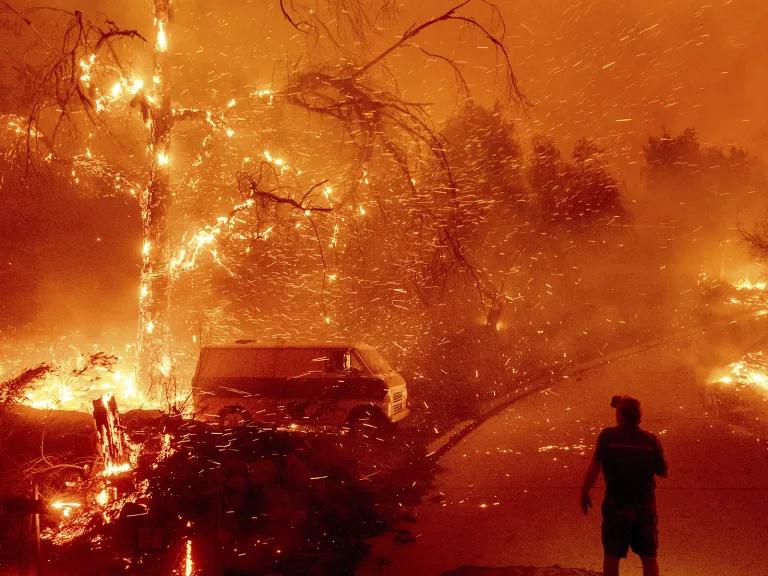
Bruce McDougal watches embers fly over his property as the Bond Fire burns through the Silverado community in Orange County, California, on December 3, 2020.
Noah Berger/AP Photo
Wildfire resilience
Conservation measures to protect mature forests are some of our best tools to manage the increasing threat from wildlfires. Old-growth trees are not only important natural climate solutions in themselves, absorbing and storing tons of carbon, but they are generally more resilient to wildfire. Older, larger trees absorb and retain more water, and play important roles in regulating the surrounding forest’s climate—one of many reasons why climate advocates are pressing decision makers to prohibit logging in federal forestland.
Climate adaptation plans for fire-prone regions should account for the health threats of smoke exposure, including by establishing systems that inform vulnerable communities about hazards, and providing indoor refuges where needed, such as for unhoused populations. Individual hospitals in California and Colorado use air quality tools to keep indoor environments safe for patients and staff from wildfire smoke. More broadly, energy efficiency retrofits to upgrade drafty buildings where windows are the only option for ventilation—a common problem in a lot of older housing stock—will be essential for cities to ensure residents’ homes are safe, healthy, and affordable places to live as the climate crisis accelerates.
A handful of states have taken steps to protect outdoor workers from high levels of wildfire smoke, including Washington, Oregon, and California (the first in the nation to do so, in 2019). The rules outline requirements for employers to limit workers’ exposure to smoky air—such as through providing respirator masks—and to increase rest time or work time in an area with filtered air.
Communities at the wildland-urban interface, where development abuts natural areas and where wildfire problems are more pronounced, must also take measures to protect property. A wide range of simple fire-wise fixes can help keep fires from growing out of control and help firefighters to stay safe on the job.
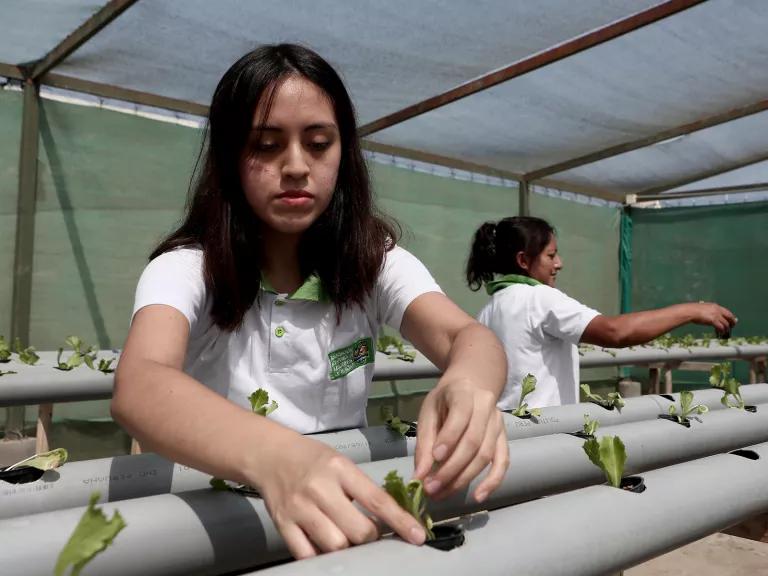
A worker tending to aquaponics in the Huacho province of Peru on June 2, 2023. The woman-operated project combines fish farming with the production of vegetables at a time when climate change is wreaking havoc on local coastal ecosystems.
Klebher Vasquez/Anadolu Agency/Getty
Adapting our food supply to climate change
Many economic sectors are bearing the impacts of our warming world—and that includes major food sectors, particularly agriculture and fisheries. Though transforming how we manage these sectors may be a daunting task, the benefits outweigh the costs: Climate-resilient agriculture and climate-ready fisheries and fishing communities make our food system more diverse, healthy, and flexible.
The Impact of Climate Change on Agriculture
Farmers are already feeling the impacts of climate change. Severe droughts in California, the Great Plains, and the Midwest have taken heavy tolls on crops over the past decade, while flooding events along the Arkansas, Mississippi, and Missouri rivers caused more than $20 billion in damage in America’s bread basket, just in 2019 alone. The impacts of these and other extreme weather events ripple across the global food supply chain, contributing to food shortages, higher food prices, and worsening food insecurity.
Industrial farming is particularly vulnerable to the effects of climate change because it already neglects soil health, making crops less able to withstand environmental changes as well as overly reliant on harmful fertilizers and pesticides. As climate change brings new pests, pathogens, and weed problems, the threats to our lands multiply. In turn, crop failures will force farmers to become more dependent on disaster relief programs or more reliant on the taxpayer-funded Federal Crop Insurance Program—currently the most expensive farm subsidy, costing a cumulative $90 billion from 2011 to 2021.
How Does Agriculture Adapt to Climate Change?
Many solutions are already being embraced on farms of all scales. These include transitioning to various applications of regenerative agriculture—which is based on Indigenous knowledge and practices—and initiatives to build more diverse regional food systems.
Improving soil health
Techniques like conservation tillage, cover crops, and crop rotation all boost soil’s sponge-like qualities (thereby giving the ground a better chance of soaking up rainfall and holding on to it during dry periods) and help build climate resilience.
For example, using cover crops on just half the acres devoted to corn and soybeans in the United States could help capture more than 19 million metric tons of carbon each year and help the soil retain an additional trillion gallons of water. Carbon-rich soils need fewer fertilizers and pesticides, which saves farmers money, and the soil doesn’t erode as much.
Cover crops also protect soil from extreme heat, while no-till and cover crops can both increase yield. This is why, since 2017, the Iowa Department of Agriculture and Land Stewardship has offered a $5-per-acre “good farmer discount” on crop insurance premiums to farmers who plant cover crops to give a financial incentive.
Clean water and water efficiency
Farmers who rely on drip irrigation, a practice of applying small amounts of water and fertilizer uniformly to the crop root zone, use about 20 percent less water than those who use traditional gravity irrigation. Drip irrigation eliminates runoff, curbs evaporation, and limits the erosion of soil caused by wind gusts. Adjusting the amount of water used at different stages of growth can also help farmers efficiently use their limited water supplies.
Cover crops can also reduce the amount of nitrates in water by 28 percent and phosphorus by 50 percent, creating cleaner farm water runoff. This improves the water quality downstream and causes fewer harmful algal blooms in nearby lakes and rivers.
Agroforestry
Many farmers incorporate agroforestry into their operations in order to help improve crop yields and make surrounding lands and waterways more resilient to climate impacts. Techniques include cultivating trees, shrubs, and other plants along the edges of streams, lakes, or wetlands that border farmlands; incorporating trees into livestock pastures; alternating rows of crops with rows of trees or woody plants; and planting rows of trees or shrubs as windbreaks, to protect crops from big gusts and improve soil and water quality. These tactics help preserve moisture, improve soil health, and shield crops from big temperature swings.
Agroforestry doesn’t just help a farm adapt to climate change but it also improves economic opportunities by leading to crop diversification and job creation. It can also improve the health of waterways, as was the case along the Tucannon River in Washington. There, as the result of a program that encouraged farmers to replace crops with native vegetation alongside streams to create shady banks, summer water temperatures dropped by about 10 degrees Fahrenheit. In turn, the population of local spring-run Chinook salmon rebounded.
Diversifying our farms
Climate-smart agriculture programs also incentivize diverse farming systems and food systems infrastructure that can withstand the impacts of climate change and other threats. This may mean nurturing urban farming, including addressing the systemic racism in agencies like the U.S. Department of Agriculture, which has limited access for BIPOC farmers to the loans and grants that could help them reduce food insecurity and boost resiliency in their communities. Environmental advocates championing new provisions in the federal Farm Bill seek to remedy these injustices. Cities also have a role to play, such as accommodating more urban agriculture initiatives, as Chicago did by changing its zoning laws in 2010 to boost food security.
Many rural communities, too, seek to build food sovereignty in places cut off from easy access to fresh fruits, vegetables, and protein, with climate resilience as an added benefit. For example, the Blackfeet Nation in Montana is working to create a more sustainable local food system by enabling tribal members to raise more plants and livestock and establishing a meat processing plant of their own. The tribe is also looking to incentivize conservation and climate adaptation efforts like regenerative grazing methods and other historically Indigenous practices.
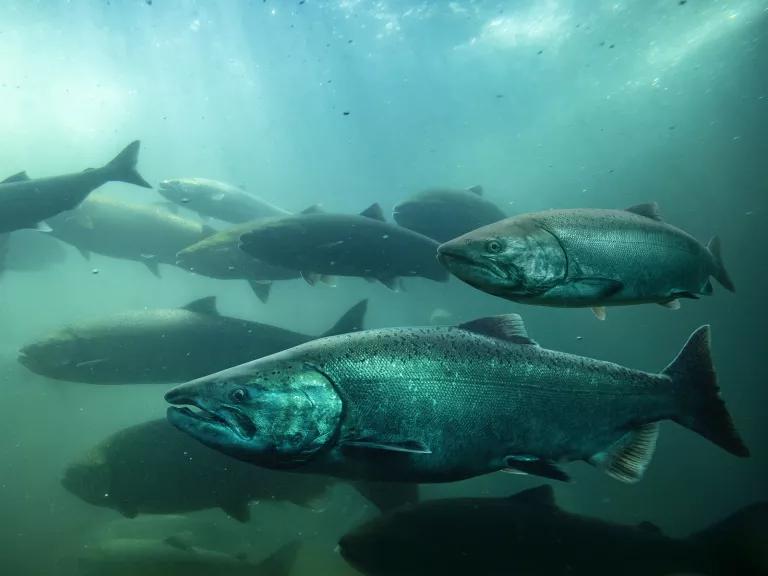
Pacific salmon swimming up the Columbia River in Oregon
Dave Alan/iStock/Getty
How Do Fisheries Adapt to Climate Change?
For an economic sector as significant as commercial and recreational fishing—which in 2020 supported 1.7 million jobs and $253 million in sales in the United States—climate adaptation is essential. Already, life underwater looks very different, with many marine species moving toward the poles or into deeper water, coastal erosion accelerating, and wetland habitats for fish and shellfish getting submerged. To shape better outcomes for our fisheries, we must enhance the resilience of the ocean ecosystems as a whole. At the same time, we must also minimize the harm on coastal communities that rely on the industry.
Fisheries management tools are key. Among those is the Magnuson-Stevens Fishery Conservation and Management Act, the primary fisheries law of the United States, which has played a critical role in curbing overfishing and rebuilding dozens of once-depleted fish stocks. While the law has long emphasized the abundance of a fish population as key to its health, marine policy experts are now pushing for changes that recognize the importance of safeguarding older, fertile females, which tend to produce more and higher-quality babies, as well as maintaining genetic diversity to help fish populations withstand climate stressors.
When it comes to shellfish, various aquaculture techniques can help protect mollusks during their larval phase from ocean acidification. Fisheries can also diversify what mollusks they catch because different species are more or less sensitive to environmental changes.
Of course, climate change is also putting pressure on freshwater fish populations and those that spend portions of their life cycle in freshwater (aka “anadromous fish”), such as salmon. Many salmon advocates are championing dam removal as a way of helping these beleaguered fish recover in waterways like the Columbia-Snake River Basin, once the most prolific salmon habitat in the world. In particular, dams on the lower Snake River, which slow the water flow, are contributing to increasingly lethal water temperatures for juvenile salmon. In 2022, advocates to remove those dams that contribute little to the economy gained ground, after the Federal Energy Regulatory Commission approved the deconstruction of four hydroelectric dams along the lower Klamath River. The decision set in motion what is expected to become the largest dam removal and river restoration project in history, and is expected to help the salmon population rebound.
Another significant solution is the 30x30 strategy, promoting the protection of at least 30 percent of our lands, rivers, lakes, wetlands, and oceans by 2030. Among other goals, the 30x30 targets intend to help safeguard marine ecosystems and the fisheries that depend on them, ensuring they continue to provide food, jobs, and cultural sustenance to billions around the world. Key components of this strategy that will directly benefit fisheries and coastal communities include safeguarding coastal habitats like seagrass beds, salt marshes, and mangroves, and establishing and preserving marine protected areas, particularly those that are critical for wildlife feeding, breeding, and migrating. Whatever the conservation plan, local buy-in is key.
Supporting climate refugees
Rising sea levels. Food shortages. Extended droughts. Supercharged hurricanes. The many impacts of climate change are leading people to uproot their lives and seek safer places to live, within their home countries and across the globe. While migration is not a new phenomenon, climate migration is accelerating. The World Bank estimated that climate change will internally displace more than 143 million people in sub-Saharan Africa, South Asia, and Latin America by 2050. Meanwhile, according to the Internal Displacement Monitoring Centre, 1.7 million people in the United States were displaced by weather-related disasters in 2020 alone.
This burden does not fall on all shoulders evenly. Indigenous communities, people of color, people in the Global South, residents of small island nations, and low-income people are the most vulnerable, as reinforced by the findings of the IPCC. And it is incumbent upon the wealthy countries (particularly the United States and Western European nations), which have emitted the lion’s share of greenhouse gases that led to the climate crisis, to help them. Specifically, the IPCC estimates that developing nations will need as much as $300 billion per year just for adaptation by decade’s end, a reality that rich nations have made some efforts to address, with a pledge to mobilize $100 billion per year toward that goal.
What are the most critical adaptations to support those who were uprooted from their homes in the aftermath of a disaster? Those that allow people to return to their communities. In 2005, Hurricane Katrina led to the largest, fastest mass migration in modern U.S. history. The mass evacuation of New Orleans gave city officials the pretext to board up and tear down affordable housing developments, where tenants were predominantly Black, so that the city could redevelop them. Even some developments that saw no significant damage were razed as part of the city’s rebuilding strategy. These decisions exemplified the phenomenon of climate gentrification, whereby a city will enable extreme weather events or other factors to uproot existing populations en masse. As a result of what transpired in New Orleans, the Black population of New Orleans has decreased by more than 100,000 people compared to 2000, whereas the city’s white population has shrank by only about 10,000.
Just and sustainable climate adaptation demands that local governments ensure any green development or urban renewal projects are accompanied by anti-displacement measures for the most vulnerable residents. Low-income communities and communities of color must also have access to new amenities for their own use and must be able to practice receiving, making decisions about, and distributing funding to places where they want to see their dollars go, in order to stave off the harmful effects of gentrification. Urban planning and zoning are key forces propelling gentrification, but done right, sustainable revitalization efforts will also promote community ownership, cultural programs, and income and workforce development for residents, as well as a system of shared governance.
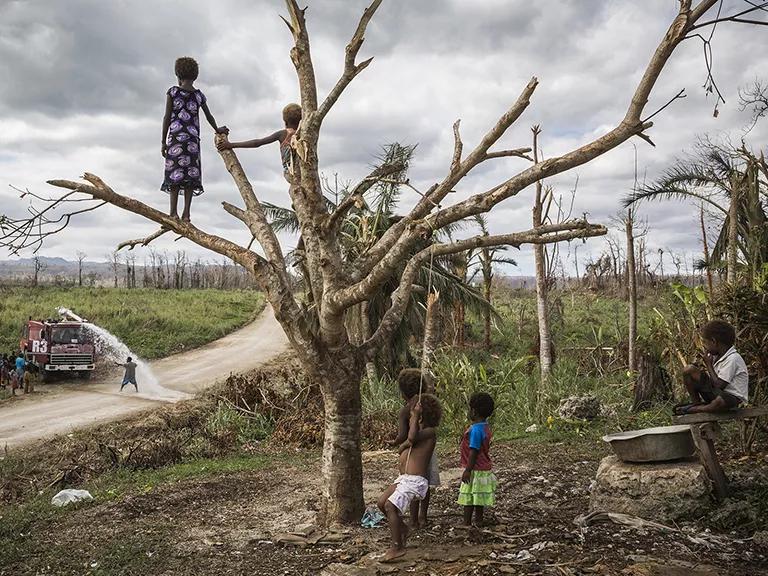
Children on Efate, the main island of Vanuatu, watch a water truck delivering supplies to their village. After Cyclone Pam hit the Pacific island-nation in March 2015, many local communities were left without fresh water.
Vlad Sokhin/Panos Pictures/Redux
The cost of inaction
Climate change is already here and doing nothing is simply not an option. The costs to many overburdened communities, people’s well-being, and the economy are simply too high. NRDC researchers have noted that the health costs alone (accounting for both air pollution and climate change) already far exceed $800 billion per year in the United States, and this price tag will only grow lest we address this crisis holistically, both through mitigating the causes of climate change and adapting to its effects.
Meanwhile, according to a 2022 report from NRDC affiliate E2 that looked at the escalating toll of billion-dollar disasters over the past four decades, every state in the country has been impacted and faces risks from extreme weather and climate damages, with a third of all losses since 1980 occurring in just five years: From 2017 to 2021, the United States experienced its four most expensive wildfires, two of its three most expensive hurricanes, and its most expensive winter storm; taken together, the economic losses from these disasters totaled $765 billion.
The economic costs are always hardest on marginalized communities. While it is true that natural disasters don’t discriminate, disasters such as flooding do have a greater impact on lower-income communities because they are the ones that can least afford to recover, rebuild, evacuate, or relocate. In the United States, the legacy of redlining also means that many Black and Latine people are living in some of the least protected areas. Droughts and agricultural losses can also disproportionately impact rural communities where farming is the primary industry. That’s why, at its core, climate adaptation must deliberately promote environmental justice.
And we have the power to make change. Every $1 spent by the federal government on resilience today—such as reducing the number of homes in flood-prone areas or increasing the resilience of infrastructure—could save $6 in future disaster-related expenses, according to a report by the National Institute of Building Sciences. Moreover, our health and the stability of our society and economy depends on an agile public health system, nimble local and regional food supply chains, sustainable infrastructure, the protection of the natural systems upon which all life depend, and steadfast international cooperation. Above all, keeping people safe demands recognition at all levels of government that supporting climate adaptation measures is a pragmatic, political, and ethical imperative. And prioritizing these investments will ensure we are ready to take on the grave challenges before us.
This NRDC.org story is available for online republication by news media outlets or nonprofits under these conditions: The writer(s) must be credited with a byline; you must note prominently that the story was originally published by NRDC.org and link to the original; the story cannot be edited (beyond simple things such as grammar); you can’t resell the story in any form or grant republishing rights to other outlets; you can’t republish our material wholesale or automatically—you need to select stories individually; you can’t republish the photos or graphics on our site without specific permission; you should drop us a note to let us know when you’ve used one of our stories.
We need climate action to be a top priority in Washington.
Tell President Biden and Congress to slash climate pollution and reduce our dependence on fossil fuels.



Sea Level Rise 101
In Planning for Climate Change, Native Americans Draw on the Past
What Is the Justice40 Initiative?